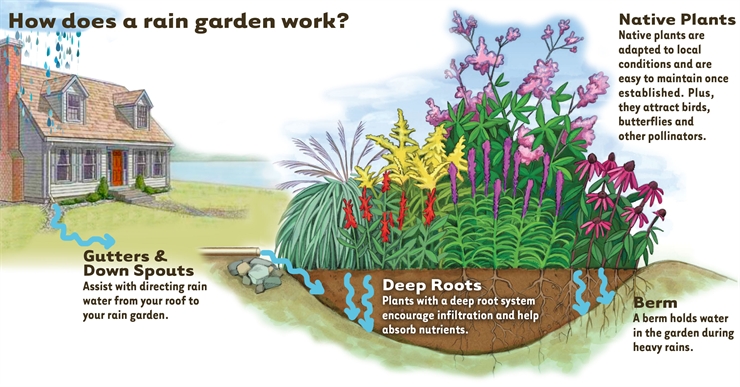Absorb Runoff by Planting a Rain Garden on Your Property!
What is a Rain Garden? A rain garden is simply a landscaped area planted with wildflowers or other native vegetation that soaks up rain water. Most are designed to catch rain from the roof of a building, however they can intercept water running off of any surface – a driveway, a yard, a sidewalk and more.

What Are the Benefits of a Rain Garden? After a rain, the garden collects the water that would otherwise run off. The water then slowly filters into the ground rather than leaving the site through a storm drain or ditch, or entering a surface water like a lake.

Is there assistance available?
Yes! We would be glad to help you!
Do you need help determining a good location for a rain garden? Or deciding how big of a rain garden is needed? How about selecting the right plants? Staff from one of the three Soil and Water Conservation Districts in the Mille Lacs Lake Watershed will visit with you at your property to discuss these issues and more.
Why Reduce Stormwater Runoff?
- Stormwater increases chances of flooding
- Stormwater carries pollutants from streets/ lawns to lakes
- Stormwater treatment by municipalities is costly
- Stormwater infiltration can recharge groundwater
How about paying for the rain garden? We may be able to help with that too. There is occasionally cost share assistance available through grants received by the MLLWMG.
Financial and technical assistance may be available to help landowners implement projects to manage stormwater runoff and control soil erosion. For information, call your county’s soil & water conservation district:
Aitkin SWCD: 218-927-7284
Mille Lacs SWCD: 320-983-2160
Crow Wing SWCD: 218-828-6197
Learn More About Plantings and Managing Runoff
The following short articles from our Learn More page provide additional information about the impact of rain gardens and plantings. Click a title to download a pdf.
Start Enjoying the Benefits of Native Trees! (February, 2021)
Salt-Tolerant Trees, Shrubs, Perennials, and Herbaceous Grasses (January, 2021)
Native Shoreline Plants (April, 2019)
Ready to Plant? (June, 2019)
Why Should I Care About Runoff? (March, 2019)
Trees – Partners in Watershed Health (October, 2018)
Is it Time to Think About Spring & Summer Flowers Yet? (January, 2018)
Five Ways to Reduce Nutrients in Lakes & Streams (January, 2017)
Visit The Ultimate Guide on Water Conservation: How To Save Every Drop to learn about how you can reduce water use in your home and other conservation steps.
